|
Europe
takes the
lead and prepares for war
In 1908, the British writer H.G. Wells published War in
the Air, a fantasy that depicted with
frightening clarity the
possibility of cities being bombarded from aircraft
and wars being determined
by air battles. As Europe felt
itself lurching closer and closer to a major war, each of
the possible combatants took stock of their
preparedness in all areas of
warfare, including air power. Even
strategists who believed aviation in the decade before World
War I was the province of
cranks and adventurers, or useful
only for reconnaissance, speculated on what role
an air force might play in
a war and how they would fare
against an airborne enemy. In the
years 1910 to 1914, the French
were certainly the most advanced
in aviation of all the European
nations.
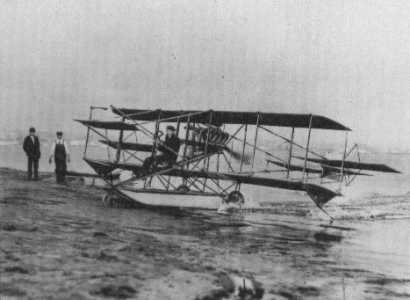
While Europe developed land-based planes
for possible military use, the
American designer
Glenn Curtiss, with U.S. Navy support, was developing
aircraft that could land on and take
off from water.
The International Exposition of
Aerial Locomotion (known as the
Aéro Exhibition) at the
Grand Palais in Paris in October 1909, just weeks after the
spectacle at Reims, made this abundantly clear. Organized by
Robert Esnault-Pelterie, 333 exhibitors displayed their
wares and aircraft, everything from balloons to airplanes to
clothes and accessories; 318 of the exhibitors were French.
On display were the Blériot plane that had made history and
Ader’s Avion of 1897 (which had not); Henry Farman’s aileron-equipped biplane;
Santos-Dumont’s lightweight Demoiselle 20; and (in the most
prominent position in the hall) Esnault-Pelterie’s R.E.P.,
with its revolutionary internally braced wing (doing away
with the need for guide wires) and the first fully enclosed
fuselage.
The French believed that their planes had
developed nicely—the monoplanes they preferred were lighter
and faster than the American biplanes. The Gnome engine,
developed by the brothers Louis and Laurent Seguin in 1909,
was quickly developing into the prototype of the next
generation of airplane power plants, and between 1911 and
1913, French aviators owned virtually every aviation record
on the books.
The two areas in which the French
believed there was room for improvement were raw speed and
manoeuvrability; the Wright aircraft had excelled n both
these aspects of flight at Le Mans and even at Reims, and
these were factors that would be important in military
situations. The French answer in the first area was to
develop flying techniques that took full advantage of
Farman’s ailerons. In September 1913, one of Blériot’s test
pilots, twenty-three-year-old Adolphe Pegoud, a flier so
reckless the press nicknamed him “the fool,” demonstrated
manoeuvres that took flying to an entirely new level.
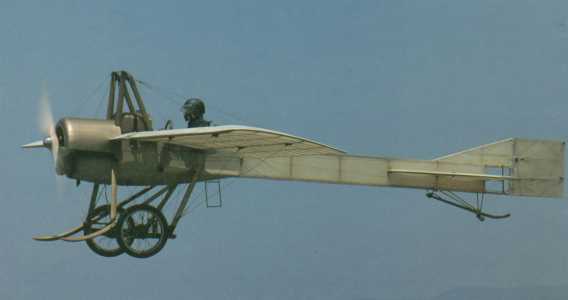
In spite of the technical
achievements of the Americans, the French influenced
aircraft design profoundly. The graceful and elegant lines
of the
Levasseur-designed Antoinette and the Blériot planes
(such as the Blériot XI shown here) set the course for
future design and
spelled the end of the
Chanute-Wright box kite approach.
His techniques allowed him to fly
upside-down and to perform all manner of loops, rolls, and
turns that were thought to be impossible. One manoeuvre had
the aircraft climb steeply until it stalled, then drop
backwards tail-first, then recover and dive, and then level
off, with the plane describing a Z in the sky. Pegoud became
a celebrated flier in World War I and was shot down in 1915
after a flying career of only three years. Fighter pilots on
both sides during the war openly acknowledged their debt to
Pegoud.
The response to the speed question was to
develop a new kind of airplane construction: the monocoque
fuselage. “Monocoque” means “single shell” and refers to the
fact that the stresses on the wings and fuselage of an
airplane can be borne by the entire shell of the aircraft
instead of by support struts and guy wires, as they were in
the earlier airplanes. The result is a lighter plane with
greater strength and structural integrity. The trail was
blazed by two planes: the Deperdussin, designed by Louis
Bechereau and built by the industrialist Armand Deperdussin;
and the Nieuport, brainchild of engineer Edouard Nieuport.
The Deperdussin, unveiled in 1912, was a sleek aircraft with
a single tractor propeller and was the first plane to
have a monocoque fuselage.
The Nieuport might be looked at as the
step between the Blériot-Voisin planes and the Deperdussin:
it did not use monocoque construction, but it was designed
to have a streamlined, fully enclosed fuselage and a
revolutionary “cowling” or (thecover that enclosed the
engine). These features, plus a flatter wing camber, gave
the aircraft speed and permitted it to set a world speed
record when introduced in 1911. The superiority of the
Deperdussin was believed demonstrated in a race known as the
Circuit of Anjou (after the county in which it was held),
held in June 1912. However, the victory of the Deperdussin
had more to do with the determination of its pilot, Roland
Garros, to fly in stormy weather than with the quality of
the aircraft. In England, aviation had a slow start.
The earliest British planes were built
and flown by an expatriate American, Samuel E Cody, who
seemed for some years to be the only one in England
interested in developing a home-grown airplane. The British
were content to rely on the Wright brothers’ invention,
taking pride that it was based on the pioneering work of Sir
George Cayley, an Englishman. The Short brothers, Oswald,
Horace, and Eustace, became licensees of the Wright patents,
and were soon the major supplier of Wright aircraft to
Europe. Meanwhile, after a brief stint flying man-carrying
kites and dirigibles, “Papa” Cody, as he was called in
the British press (when he first flew in 1908, he was forty
seven years old), turned to aircraft. Cody was a showman in
the tradition of Buffalo Bill Cody (to whom he was not
related), Texas-born and bred and, to all appearances, a
cowboy in a travelling rodeo show.
Yet Cody had an instinctive feel for
airplane design and, with virtually no schooling, he
designed some of England’s first flying machines. The first
flight of an airplane in England was made in his British
Army Airplane No. 1 on October 16, 1908. Ever the showman,
Cody’s airplanes were huge for their time; they were called
“Flying Cathedrals” because of their large wing spans and
their angular shape and pointed canard elevator wing.
Largely at the insistence of hawkish politicians like
Winston Churchill, the British army finally held trials in
April 19 12 at Larkhill for the purpose of evaluating and
commissioning military aircraft.
In spite of the fact that several
designers and builders were already producing noteworthy
aircraft, Cody’s Flying Cathedrals won handily and were the
first planes to be produced at the Royal Aircraft Factory
(formerly a balloon factory) at Farnborough. Samuel Cody
died in a crash on August 7, 1913, while testing one of his
planes. Britain had lost someone as important in promoting
flight in England as Ferber had been in France. Between 1907
and the outbreak of World War in 1914. three Englishmen
entered the field of aviation, working in relative
obscurity, but catching up year by year to the French and
the Americans, and ultimately playing a vital role in both
British aviation and the history of flight.
In 1907, Alliot Verdon Roe (or A.V. Roe,
as he was known) began building small motorized model
airplanes, and by 1 909 he had built the first aircraft made
entirely in England (that is, without French engines in
American designs), the Avro plane, a lightweight tri-plane
that barely flew, powered by a 9-horsepower engine. (At this
time, the Wrights were delivering planes to the U.S. Army
that could fly ten miles [16km] and were powered by 32-
horsepower engines.)
In 1912, Roe introduced the Avro Type F
the first aircraft with a fully enclosed cockpit (an advance
in design, but not a factor in World War I), and in 1913 he
introduced the first of a series of staggered biplanes
(where the upper wing is forward of the lower wing,
streamlining the plane further as it flies) that led to the
Avro 504, one of the most popular and durable planes of
World War I. (Some ten thousand 504s were built and many
remained in service till the mid-1930s.)
Two builders who worked independently before 1912, hut who
made important design contributions at Farnborough, were
Geoffrey de Havilland and Thomas Sopwith. De Havilland was a
designer of buses when he turned to aviation. With the help
of his brother-in-law, engineer Frank Hearle, and his
grandfather’s fortune, de Havilland built and tested his
first plane in 1909— it crashed—and the No. 2 in 1910, which
flew well enough to interest the British War Office in 1911.
The plane was renamed the F.E.1, for “Farman Experimental 1”
because it resembled a Farman biplane. De Havilland adopted
this practice of naming his plane after its inspiration when
he designed the B.E.1, which stood for “Blériot Experimental
1” and which led to the B.S.1 (the Blériot Scout 1), a
staggered-wing biplane with a monocoque fuselage and powered
by a 90- horsepower Gnome engine. The 13.5.1 became an
important fighter in the war and inspired the design of
another classic fighter plane, Tom Sopwith’s Tabloid, which
in turn led to the design of the legendary Sopwith Camel.
By 1910, Germany was convinced that it
had made a terrible mistake in directing all its energies
toward the development of airships at the expense of
airplanes. As it turned out, airships played a more
significant tactical role in World War I than airplanes, and
the absence of native design and building talent made the
Germans more prone to investigate and adapt foreign
expertise— and this resulted in the Germans being very
successful in its wartime air campaigns. The first
heavier-than-air flight in Germany was made by a visiting
Dane, J.C. Ellehammer, and Anthony Fokker. Fokker who was to
become a central figure in German wartime aviation, was
Dutch and had offered his services to the British first.
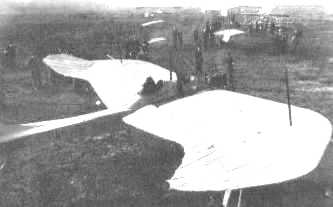
Völlmöller’s Taube, though it finished second
in the German
Circuit, was clearly a plane Germany would use if war broke
out.
The Germans hastily organized an
aeronautics industry and produced airplanes that owed a
great deal (if not everything) to French planes. The one
pre-war aircraft the Germans built and looked upon as their
own was the Taube (German for “dove”), a 1910 monoplane
designed and built by an Austrian, Igo Etrich, and
originally used by Italy against the Ottoman Turks in Libya.
The plane had a hopelessly outdated birdlike design with a
complex wing-warping system of control. The Taube was
clearly not going to lead to other, more advanced aircraft
and was considered an interim solution at best.
Yet the Taube, outfitted with a Daimler-Mercedes engine, was light
and allowed pilots to hone their flying skills, which would
he tested in the war. In Russia, Igor Sikorsky, a naval
academy graduate, designed, built, and tested the world’s
first practical four- engine airplanes, culminating in the
IIya Mouremetz, a biplane with an enormous wingspan of 113
feet (34.5m), a fully equipped and heated enclosed passenger
cabin, and an odd but usable promenade deck. Eighty planes
built along these lines were proud elements of Czar
Nicholas's air force and were the basis for the Vityaz
bombers, which were among the largest used in the war.
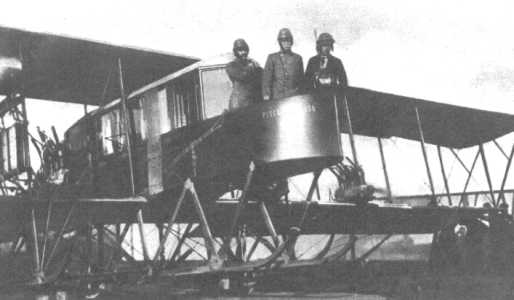
Russians were hard at work developing
large bombers. Sikorsky (right, behind the searchlight)
stands atop the observation deck of the Ilya Mouremetz.
The situation in the United States at this time was, to say
the least, paradoxical. On the one hand, flight had been
developed by Americans to a very advanced stage by the
Wright brothers and Glenn Curtiss, and there was a clear
notion among military leaders that this was a technology the
country had to develop for the sake of national security.
More than ever before, America felt a greater connection to
the rest of the world, particularly to its own western
states and Europe, and flight offered the best prospect of
transporting people across oceans and continents. (And the
entire rambunctious ethos of flight was perfectly suited to
the American mentality and Yankee ingenuity.)
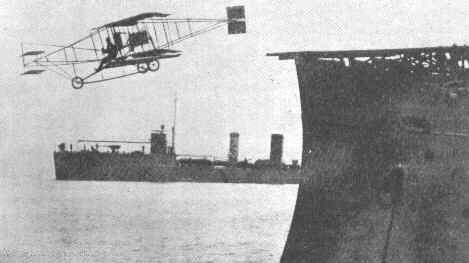
Eugene Ely, a Curtiss exhibition pilot,
makes the first take-off from the deck of
the U.S.S. Birmingham on November 14, 1910.
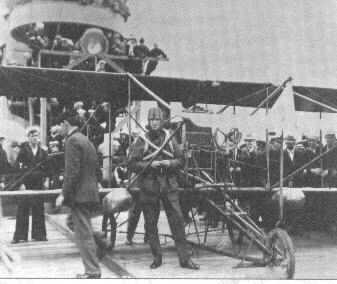
Ely’s first take-off from and landing on
the deck
of a ship (the U.S.S. Pennsylvania) took place at
the San Francisco Air Meet on January 18, 1911.
On the other hand, President Wilson
was determined to keep America out of the war, and one
element in the strategy to do so was to keep American
forces—forces that could be used to provoke America into
entering the conflict—at minimum strength. The only branch
of the American armed forces that was enlarged for defensive
purposes was the navy. (Ironically, it was the sinking of a
ship, the Lusitania, by a German U-boat, that brought
America into war.)
While the U.S. government
could control procurement and development, it could not halt
progress in design and aviation. American planes developed,
particularly sea- planes, which would play an important role
both in the post-war development of civil aviation and in
naval aviation, particularly in the development of the
aircraft carrier, which would prove critical in World War
II.
American inventors created the first bombsight (Riley Scott
in 1911) and adapted the gyroscope to airplane stability
(Lawrence Sperry installed the gyroscope developed by his
father, Elmer, in a Curtiss seaplane in 1914). Americans had
been first to use radio to communicate with the ground from
an airplane (Baldwin and McCurdy n 1910), accumulating more
experience than anyone else in using radio communication in
flight. And Americans had done the most testing of aerial
bombing and reconnaissance, beginning with Glenn Curtiss’
display on June 30, 1910, of the successful “sinking” of a
dummy battleship on Lake Keuka by dummy chalk bombs (scoring
fifteen direct hits out of seventeen passes).
It was clear as early as 1911 that, while
Europe might momentarily take the lead in aviation, being
confronted directly with the war, America was going to
develop the airplane and its military capabilities at its
own pace, to be used when necessary, either in this war or
the next.
|
